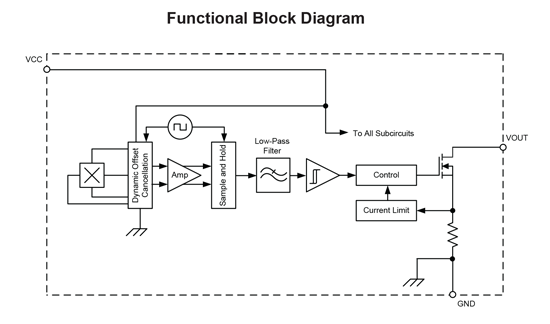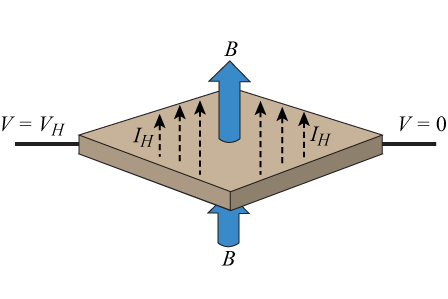Hall-Effect-Sensor-Technology

The Hall effect is named after Edwin Hall, who in 1879 discovered that a voltage potential develops across a current-carrying conductive plate when a magnetic field passes through the plate in a direction perpendicular to the plane of the plate.
The fundamental physical principle behind the Hall effect is the Lorentz force. When an electron moves along a direction, v, perpendicular to the applied magnetic field, B, it experiences a force, F, normal to both the applied field and the current flow. In response to this force, the electrons move in a curved path along the conductor (Hall element). Because of this, a net charge, and therefore, a voltage, develops across the plate. By this property, the Hall effect is employed as a magnetic sensor.
Allegro Hall-effect sensor integrated circuits (ICs) incorporate a Hall element with other circuitry, such as op-amps and comparators, to make digital position sensors and speed sensors, as well as linear and angle sensors with analog outputs.

In many cases, Allegro magnetic sensor ICs also incorporate proprietary packaging that includes a “back-bias” magnet to enable the sensor to sense the location of a ferrous (magnetic) target rather than an external magnetic field. The target, e.g., a steel gear, modifies the magnetic field from the integrated magnet. Differential sensing and advanced algorithms are used to optimize performance and compensate for dynamic or sudden air gap changes, vibration, and mechanical tolerances.
Hall-effect sensors also lend themselves to non-contact current sensing, as the current in a conductor creates a magnetic field that is proportional to the magnitude of the current. Unique packaging creates galvanically isolated, small footprint current sensing ICs with very low insertion losses.
Since their inception, Allegro has pioneered several major advances in the field of Hall-effect sensor ICs including chopper stabilization, vertical Hall-effect technology, circular vertical Hall (CVH) arrays, and non-intrusive high-speed hardware diagnostics. Visit each section below to learn more.
Chopper Stabilization
The signals produced by the Hall effect within an integrated circuit are tiny—possibly only microvolts of signal. This signal can easily be corrupted by noise or offsets such as those induced by temperature changes or mechanical stress. State-of-the-art sensors employ chopper stabilization to cancel out these effects.
Learn more »
Multi-Dimensional Sensing
Traditional Hall-effect sensors are only sensitive to magnetic fields perpendicular to the plane of the die. Sophisticated design and fabrication techniques have made it possible to create vertical Hall elements that allow a sensor to determine field direction as well as magnitude. This can be leveraged to build more sensitive switches, better rotary position sensors, and angle sensors.
Learn more »
Diagnostics for Built-In Self-Test (BIST)
Hall-effect sensors are often used in safety-critical applications, including automobiles. The development of fast, non-intrusive self-diagnostics (BIST) has enabled sensors to meet the most stringent safety standards including ISO 26262:2011.
Learn more »
Insights and Innovations
Giant Magnetoresistance versus Hall-effect: A Comparison of Technologies for Speed Sensor Applications
